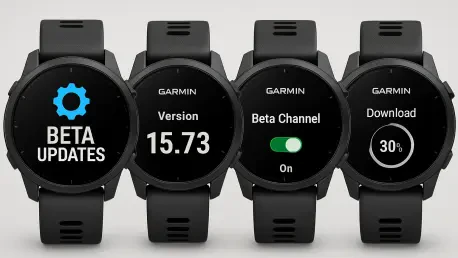In an era where wearable technology continues to redefine how fitness and daily activities are tracked, Garmin has once again captured attention with its latest beta updates for a wide range of smartwatches, signaling the company’s relentless pursuit of innovation and user satisfaction. These updates, rolled out to both budget-friendly and premium models, address long-standing issues like battery drain while introducing cutting-edge features to ensure Garmin’s devices remain competitive in a crowded market. This development not only caters to casual users but also appeals to dedicated athletes and adventurers who depend on reliable, feature-packed wearables for their pursuits. As the smartwatch industry evolves, such updates highlight how brands must adapt swiftly to meet diverse user expectations while maintaining a balance between functionality and performance.
Enhancements Across the Smartwatch Lineup
Boosting Functionality for Entry-Level Devices
Garmin’s latest beta update for the Vivoactive 6, version 15.05, targets one of the most persistent complaints among users: rapid battery drain that has hindered the device’s usability for many. This update, accessible through the public beta program, appears to optimize power consumption, offering hope to those frustrated by frequent recharging. Beyond battery fixes, subtle yet impactful usability enhancements have been introduced. Features like direct access to Morning and Evening Reports from the Notification Center and a new gesture to dismiss smart notifications by covering the screen with a hand add a layer of convenience. These tweaks, though minor, reflect a thoughtful approach to improving everyday interactions with the device. While these changes are promising, their beta status means they are still under testing, and users should be prepared for potential hiccups as refinements continue based on real-world feedback.
Another key aspect of the update for entry-level devices like the Vivoactive 6 lies in Garmin’s strategy to democratize access to improved performance. By focusing on core issues such as battery life, the company ensures that even users of more affordable models experience meaningful upgrades without feeling left behind. This inclusivity sets a precedent in the industry, where budget devices often receive less attention compared to flagship products. Additionally, the beta program allows early adopters to play a crucial role in shaping the final release by reporting issues and suggesting improvements. This collaborative process underscores a commitment to user-centric design, ensuring that the final software rollout addresses real needs. As these updates progress, they could redefine expectations for what entry-level smartwatches can deliver in terms of reliability and user experience.
Elevating Premium Models with Advanced Features
For high-end models like the Fenix 8 and Tactix 8, the beta update version 20.07 brings a robust set of enhancements that cater to the sophisticated demands of serious users. Among the standout additions are four new features, including a cycling VO2 Max watch face complication and support for GPI files, which enhance customization and data tracking for specialized activities. Other improvements, such as automatic touch lock/unlock during strength training and better touch access to the keyboard layout menu, streamline interactions during intense workouts. These updates demonstrate a keen understanding of the nuanced needs of users who rely on these devices for rigorous outdoor and fitness challenges. With such targeted enhancements, Garmin reinforces its position as a leader in premium wearable technology.
Equally significant in the update for premium models is the extensive resolution of over 30 bugs and performance issues, ranging from system crashes to lag and black screens. This comprehensive approach to troubleshooting ensures that users of the Fenix 8 and Tactix 8 encounter fewer disruptions, even during demanding usage scenarios. The detailed list of fixes, available through official channels, highlights Garmin’s meticulous effort to refine every aspect of the user experience. By addressing both minor annoyances and critical failures, the update builds trust among users who invest in top-tier devices expecting flawless performance. Furthermore, the beta nature of these changes invites feedback from a dedicated user base, which could lead to even more polished software in the final release. This focus on perfection sets a high standard for what premium smartwatches should offer.
Strategic Approach to Software Development
Leveraging Beta Testing for Iterative Improvement
Garmin’s decision to release these enhancements as beta updates reflects a strategic emphasis on iterative improvement through user feedback. By allowing early adopters to test new features and report issues, the company gains valuable insights into real-world performance that might not surface during internal testing. This method helps identify unforeseen bugs and usability challenges, ensuring that the final software release is as robust as possible. It also fosters a sense of community among users who feel involved in the development process, as their input directly influences the product’s evolution. While this approach carries the risk of exposing users to unresolved issues, it ultimately contributes to a higher quality end product that aligns closely with customer expectations and needs.
Another dimension of Garmin’s beta testing strategy is the cautious rollout that balances innovation with reliability. Users are advised to weigh the potential benefits of early access against the risks of encountering glitches, especially if their smartwatch is critical for daily tasks or specialized activities. This transparency in communication helps manage expectations and ensures that only those willing to accept the beta’s experimental nature opt in. Moreover, the process allows Garmin to prioritize fixes and features based on user priorities, creating a tailored development cycle. As feedback pours in, the company can adjust its focus, potentially accelerating solutions for the most pressing concerns. This adaptive methodology positions Garmin as a brand that not only innovates but also listens, fostering loyalty in a competitive landscape.
Balancing Inclusivity and Specialization in Updates
A notable trend in Garmin’s recent beta updates is the effort to cater to a broad spectrum of users, from casual fitness enthusiasts to hardcore adventurers. For entry-level devices like the Vivoactive 6, the focus on fundamental issues like battery life ensures accessibility and satisfaction for everyday users who may not need advanced features. Simultaneously, the comprehensive updates for premium models like the Fenix 8 address the complex demands of niche audiences who require cutting-edge functionality. This dual approach prevents any segment of the user base from feeling neglected, reinforcing Garmin’s reputation as a versatile brand capable of meeting diverse needs within the smartwatch market.
Further emphasizing this balance, Garmin’s updates showcase a nuanced understanding of how different devices serve distinct purposes. While budget models receive essential fixes to maintain reliability, premium devices are enhanced with specialized tools that elevate their utility for specific activities like cycling or strength training. This tailored strategy ensures that each product tier evolves in a way that maximizes its value to the intended audience. By maintaining this equilibrium, Garmin not only retains its existing customers but also attracts new ones who seek wearables that align precisely with their lifestyle or performance goals. The beta phase serves as a testing ground for this inclusive yet specialized approach, promising refined outcomes in the near future.
Reflecting on Continuous Innovation
Looking back, Garmin’s rollout of these beta updates marked a significant moment in its ongoing commitment to enhancing smartwatch performance across various models. The targeted fixes for battery issues in the Vivoactive 6, alongside the extensive feature additions and bug resolutions for the Fenix 8 and Tactix 8, demonstrated a clear dedication to addressing user concerns with precision. The reliance on beta testing to refine software before a full release further showcased a methodical approach to product development. For users eager to experience these advancements, joining the public beta program offered a firsthand look at the potential improvements, despite the inherent risks of early adoption. Moving forward, staying updated on official announcements and participating in feedback loops could ensure that the final releases meet the highest standards, paving the way for even more seamless and innovative wearable experiences.









